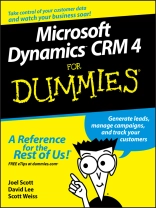Customer relationship management, or CRM, is certainly a hot topic
in business today. If you have a small or medium-sized business,
chances are you’re already aware of all it can do for you.
But with so many options and so much to think about, how do you get
a CRM system in place with a minimum of hassle? Well, Microsoft
Dynamics CRM 4 For Dummies is a great place to start!
Written by veteran CRM experts Joel Scott and David Lee, this
friendly guide will have you understanding and using
Microsoft’s CRM solution in a jiffy. Whether you’re
considering a CRM system for the first time or you’ve decided
to switch from another system to Microsoft Dynamics CRM, this book
will make it easy to:
* Maintain and manage all your customer information
* Personalize Microsoft CRM to work for your business
* Set up CRM to support sales, marketing, and customer
service
* Use the Outlook client
* Manage territories and business units
* Create and manage activities
* Generate quotes and invoices
* Implement and manage a marketing campaign
* Work with contracts, and much more
Microsoft Dynamics CRM 4 For Dummies is packed with
information on the latest version, It will help you get a unified
view of your customer information and interactions through
integrated sales, marketing, and customer service features. And
that, as every business owner knows, is important to improving your
bottom line!
विषयसूची
Introduction.
Part I: Microsoft CRM Basics.
Chapter 1: Taking a First Look at Microsoft CRM 4.
Chapter 2: Using the Outlook Client — Or Not.
Chapter 3: Navigating the Microsoft CRM System.
Part II: Setting Things Up.
Chapter 4: Personalizing Your System.
Chapter 5: Managing Territories.
Chapter 6: Managing Business Units and Teams.
Chapter 7: Using the Product Catalog.
Chapter 8: Understanding Security and Access Rights.
Chapter 9: Implementing Business Rules and Workflow.
Chapter 10: Creating and Running Reports.
Part III: Managing Sales.
Chapter 11: Setting Sales Quotas and Dealing with Forecasts.
Chapter 12: Handling Leads and Opportunities.
Chapter 13: Working with Accounts and Contacts.
Chapter 14: Creating and Managing Activities.
Chapter 15: Using Notes and Attachments.
Chapter 16: Generating Quotes, Orders, and Invoices.
Chapter 17: Setting Up Sales Literature and Dealing with
Competitors.
Chapter 18: Implementing Sales Processes.
Part IV: Making the Most of Marketing.
Chapter 19: Targeting Accounts and Contacts.
Chapter 20: Managing Campaigns.
Chapter 21: Integrating Your Web Site.
Part V: Taking Care of Your Customers.
Chapter 22: Working with Cases.
Chapter 23: Managing Your Subjects.
Chapter 24: Creating and Using the Knowledge Base.
Chapter 25: Managing Queues.
Chapter 26: Working with Contracts.
Part VI: The Part of Tens.
Chapter 27: The Top 10 (or So) Add-on Products for Microsoft CRM
4.
Chapter 28: Ten Ways to Get Help.
Appendix A: Converting to Microsoft CRM.
Appendix B: Managing Your Data.
Index.
लेखक के बारे में
Joel Scott is president of Computer Control Corporation and a well-known speaker on CRM and related technologies. David Lee is president of Vertical Marketing Inc., a software consulting firm. Scott Weiss is president and CEO of Core Solutions, Inc., a CRM consulting firm.












